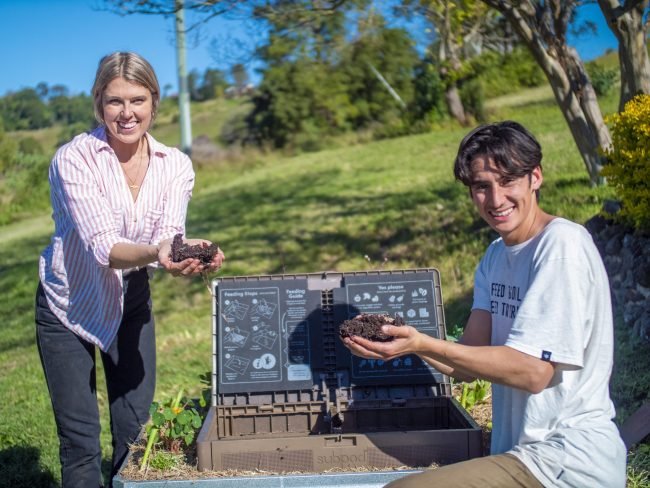“Feed the soil, feed the world…”
Subpod is a modular in-ground vermiculture composting system, designed to make composting a breeze for almost anyone, anywhere. Ideally paired with a sleek Subpod raised garden bed, Subpod converts household organic waste into a powerhouse of nutrient-rich soil, while doubling as a handsome and hardy garden bench.
- No smell
- No mess
- No pests
- No stress
Let the worms do the hard work
It creates a safe environment for compost worms and aerobic (odorless) microbes to convert organic household waste into vermicompost.
Vermicompost (vermi-compost) is the product of the decomposition process using various species of worms, usually red wigglers, white worms, and other earthworms, to create a mixture of decomposing vegetable or food waste, bedding materials, and vermicast.
This process is called vermicomposting, while the rearing of worms for this purpose is called vermiculture.
The worms move through the perforations in the underground part, aerating and carrying those nutrients into the surrounding soil, creating an optimally fertile environment for plants to thrive.

Subpod creates a closed-loop system for all your organic household waste.
Yep, you can Subpod that!
Compost worms will eat almost anything organic. You can Subpod these things:
- Kitchen scraps
- Leftovers
- Used tissues
- Scrap paper and cardboard
- Natural textiles
- Sawdust
- …and heaps more!
Subpod is simply better
Conventional household compost systems, such as tumblers, worm towers, and those ubiquitous big black buckets, sit above the ground where the material, worms and microbes are exposed to extreme temperatures.
When compost gets too hot, and not correctly managed, it becomes anaerobic, and turns into a foul-smelling, greenhouse-gas-emitting sludge that attracts vermin and makes composting a drag – as well as a complete waste of time. Managing these systems is labor-intensive and difficult. Subpod eliminates these issues and is practically maintenance-free.

Composting made easy
Subpod features two distinct bays. One side of the divider is fed, and the worms fill this area with nutrient-dense castings (poo). When it’s full, the user feeds the other side and the worms are drawn across. The first bay is now ripe for harvest, full of vermicompost ready to use elsewhere in the garden or for indoor plants. Level indicators and simple instructions on the inside of the lid make the process easy to understand. Above the ground, Subpod’s ventilation system helps to keep the compost aerobic and odourless.
The Subpod story
Subpod was invented by artist and eco-designer Andrew Hayim De Vries, in the back of his Byron Bay workshop. Andrew wanted to create a sustainable, easy-to-use compost system for the average person. After a decade of research and experimentation, he developed Subpod, and met Saadi Allan, head of the marketing team behind record-breaking crowdfunded start-up, Flow Hive. Saadi helped with Subpod’s 2019 crowdfunding campaign which raised over $350K, surpassing its goal by 300 percent, and continues to support the business as its CEO.

The Subpod philosophy
As a company they are an advocate of the circular economy, which aims for sustainability by recycling and reusing resources. The unit facilitates a closed-loop system for food waste, keeping it out of landfill, minimising its greenhouse impact, and using that waste to create more food.

Each year, every unit diverts 750kg of food waste from landfill and more than 300kg of CO2 from the atmosphere
Food waste goes in, fresh food comes out. Simple.
The Subpod community
More than 14,000 customers are using Subpod and the feedback has been overwhelmingly positive. Subpods have been sold in Australia, America, and the United Kingdom – over halfway to the company’s 2020 goal of converting 20,000 people to composting.
Social Media and Web links
- Instagram: https://www.instagram.com/thesubpod/
- Facebook: https://www.facebook.com/subpod
- Website: https://subpod.com/
- Growhub: https://growhub.subpod.com

